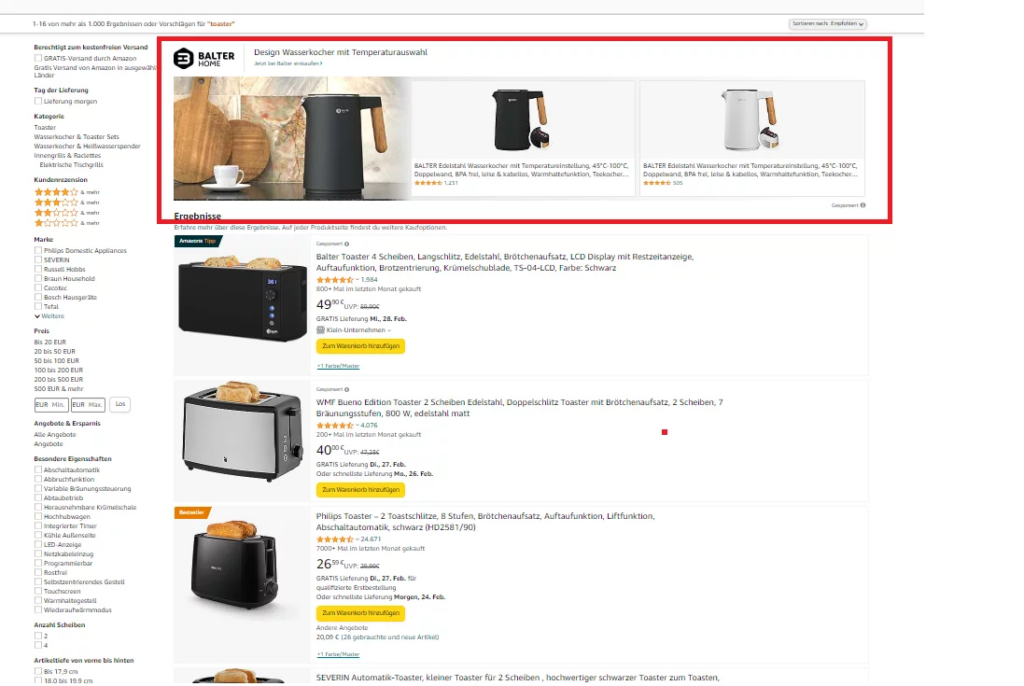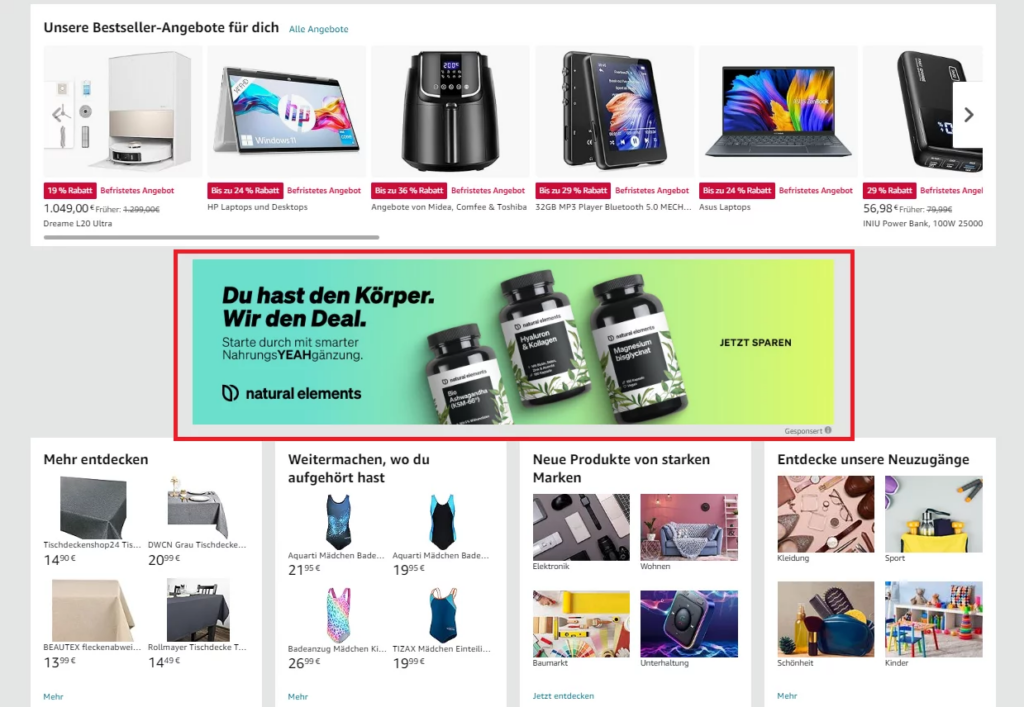Venturing into the Amazon marketplace can be thrilling yet challenging. With millions of products and sellers, distinguishing your business from the competition necessitates a strategic advertising approach. Amazon provides a range of ad types tailored to different business objectives and products. This detailed guide will assist you in navigating the which ad types should you use on Amazon and selecting the optimal one for your new business. We’ll delve into the specifics of each ad type, discuss their advantages, and offer practical tips to maximize your advertising success.
If you’re brand new to Amazon PPC read our Ultimate guide for 2024 first.
Exploring Amazon’s Advertising Ecosystem
Amazon’s advertising platform is designed to help sellers boost their visibility, drive sales, and enhance brand recognition. The primary ad types available on Amazon include:
- Sponsored Products
- Sponsored Brands
- Sponsored Display
- Amazon DSP (Demand-Side Platform)
Each ad type has its distinct features, benefits, and best-use scenarios. Understanding these distinctions is crucial for choosing the most suitable ad type for your business.
Sponsored Products
Overview
Sponsored Products are keyword-targeted ads that appear within search results and on product detail pages. These ads closely resemble organic search results, making them less intrusive and more likely to attract clicks from potential buyers.

Benefits
- Increased Visibility: Sponsored Products ads elevate your products to the top of search results, enhancing their visibility to shoppers.
- Cost-Effective: These ads operate on a cost-per-click (CPC) model, meaning you only incur costs when someone clicks on your ad.
- Relevance: Since these ads are keyword-targeted, they reach customers actively searching for products similar to yours.
Best Use Cases
- New Product Launches: To gain initial traction and visibility.
- Seasonal Promotions: To boost sales during peak shopping seasons.
- Competitive Categories: To stand out in crowded markets.
Tips for Success
- Keyword Research: Utilize Amazon’s keyword tools to identify relevant and high-traffic keywords.
- Bid Strategically: Set competitive bids to ensure your ads appear in prominent positions.
- Optimize Product Listings: Ensure your product listings are optimized with high-quality images, detailed descriptions, and positive reviews to increase conversion rates.
Sponsored Brands
Overview
Sponsored Brands ads are designed to promote your brand and product portfolio. These ads appear in prominent positions within search results and feature your brand logo, a custom headline, and multiple products.

Benefits
- Brand Awareness: Sponsored Brands ads are excellent for building brand recognition and loyalty.
- Enhanced Visibility: These ads appear at the top of search results, providing high visibility.
- Customizable: You can create custom headlines and select products to feature in the ad, allowing for tailored messaging.
Best Use Cases
- Brand Building: To establish and promote your brand on Amazon.
- Cross-Selling: To showcase complementary products and encourage shoppers to explore your entire product line.
- Promotions and Deals: To highlight special offers and drive traffic to your store.
Tips for Success
- Creative Content: Use compelling headlines and high-quality images to capture attention.
- Brand Store: Create an Amazon Brand Store to provide a cohesive shopping experience and drive traffic from your ads.
- Monitor Performance: Regularly review ad performance and adjust your strategy based on insights and metrics.
Sponsored Display
Overview
Sponsored Display ads are display ads that target customers both on and off Amazon. These ads appear on Amazon product detail pages, customer review pages, and even on third-party websites and apps.

Benefits
- Retargeting: Sponsored Display ads are ideal for retargeting customers who have viewed your products but haven’t made a purchase.
- Wider Reach: These ads extend beyond Amazon’s platform, reaching potential customers across the web.
- Automated Targeting: Amazon uses machine learning to automatically target relevant audiences.
Best Use Cases
- Retargeting: To re-engage customers who have shown interest in your products.
- Complementary Products: To promote products related to those customers have already purchased or viewed.
- Brand Awareness: To reach new customers and drive traffic to your product pages.
Tips for Success
- Segment Audiences: Create separate campaigns for different audience segments, such as past purchasers and product viewers.
- Ad Creatives: Use eye-catching visuals and clear call-to-action (CTA) to entice clicks.
- Measure and Optimize: Track performance metrics and optimize your campaigns based on the data.
Amazon DSP (Demand-Side Platform)
Overview
Amazon DSP allows you to programmatically buy video and display ads both on and off Amazon. This platform provides access to Amazon’s extensive customer data, enabling precise targeting based on shopping behavior and interests.
Benefits
- Advanced Targeting: Utilize Amazon’s customer data to target specific demographics, interests, and behaviors.
- Diverse Ad Formats: Access a variety of ad formats, including video, display, and audio ads.
- Expanded Reach: Reach customers across Amazon’s owned and operated sites, as well as third-party websites and apps.
Best Use Cases
- Comprehensive Campaigns: To run complex, multi-channel advertising campaigns.
- Brand Awareness: To build brand recognition and loyalty across a broad audience.
- Product Launches: To create buzz and anticipation for new products.
Tips for Success
- Leverage Data: Use Amazon’s insights to inform your targeting strategy and reach the most relevant audiences.
- Creative Diversity: Experiment with different ad formats and creatives to see what resonates best with your audience.
- Track and Adjust: Monitor your campaign performance and make data-driven adjustments to improve results.

Choosing the Right Ad Type for Your Business
So which ad type should I use on Amazon for starting a business? This depends on several factors, including your business goals, budget, and the nature of your products. Here’s a step-by-step guide to help you decide:
Define Your Goals
- Sales Generation: If your primary goal is to drive sales, Sponsored Products and Sponsored Brands are excellent choices.
- Brand Awareness: For building brand recognition, consider Sponsored Brands and Amazon DSP.
- Retargeting: If you want to re-engage potential customers, Sponsored Display is ideal.
Consider Your Budget
- Limited Budget: Sponsored Products are cost-effective and offer good returns on investment.
- Larger Budget: If you have more to spend, Amazon DSP provides advanced targeting options and a broader reach.
Analyze Your Competition
- High Competition: In competitive categories, Sponsored Products can help you gain visibility quickly.
- Niche Markets: For niche products, Sponsored Display can effectively target specific audiences.
Evaluate Your Product Portfolio
- Multiple Products: If you have a range of products, Sponsored Brands can showcase your portfolio effectively.
- Single Product Focus: For single product promotion, Sponsored Products are straightforward and effective.
Practical Tips for Optimizing Your Ads
Regardless of the ad type you choose, optimizing your campaigns is crucial for achieving the best results. Here are some practical tips to help you get the most out of your Amazon ads:
Conduct Thorough Keyword Research
Utilize Amazon’s keyword tools and third-party platforms to identify high-performing keywords relevant to your products. Incorporate these keywords into your ad campaigns to ensure your ads reach the right audience.
Create Compelling Ad Creatives
High-quality images, clear headlines, and engaging descriptions are essential for capturing the attention of potential customers. Ensure your ad creatives are visually appealing and accurately represent your products.
Optimize Product Listings
Your product listings should be optimized with detailed descriptions, bullet points, high-resolution images, and positive customer reviews. An optimized listing increases the chances of converting clicks into sales.
Monitor and Adjust Campaigns
Regularly review your campaign performance metrics, such as click-through rates (CTR), conversion rates, and return on ad spend (ROAS). Use this data to make informed adjustments to your bids, keywords, and ad creatives.
Utilize A/B Testing
Experiment with different ad variations to see which performs best. A/B testing allows you to compare different headlines, images, and targeting strategies, helping you identify the most effective approach.
Conclusion
Choosing the right ad type for your starting business on Amazon is a critical decision that can significantly impact your success. By understanding the features and benefits of each ad type, defining your business goals, and implementing best practices for optimization, you can create effective ad campaigns that drive sales, increase visibility, and build brand awareness. Whether you opt for Sponsored Products, Sponsored Brands, Sponsored Display, or Amazon DSP, a well-planned and executed advertising strategy will help your business thrive in the competitive Amazon marketplace.
Additional Resources
For further reading and resources, consider exploring the following:
- Amazon Advertising Help Center: Provides detailed guides and FAQs on all ad types.
- Amazon Seller University: Offers video tutorials and courses on various aspects of selling and advertising on Amazon.
- Third-Party Tools: Acosbot!
By leveraging these resources and staying informed about the latest trends and best practices in Amazon advertising, you can continuously refine your strategy and achieve long-term success for your starting business. Once you decide which ad type should you use on amazon, try Acosbot for free and optimize your ads with AI.



